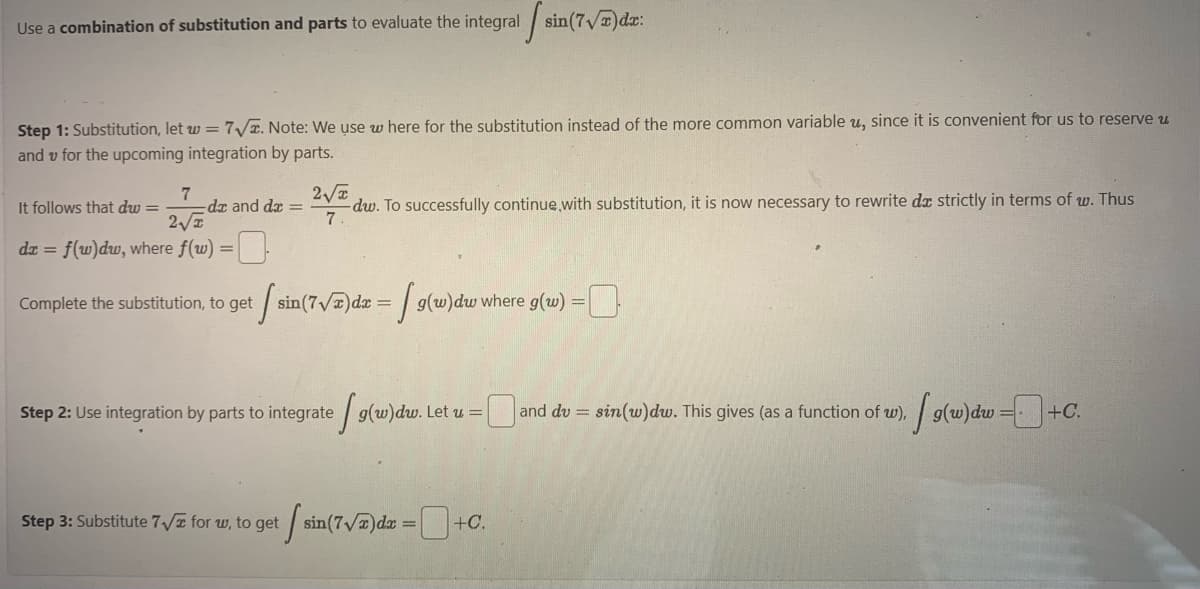Use a combination of substitution and parts to evaluate the integral sin(7√x)dx: Step 1: Substitution, let w = 7√. Note: We use w here for the substitution instead of the more common variable u, since it is convenient for us to reserve u and v for the upcoming integration by parts. It follows that dw = 27 dz -dx and dx = 2√x dx = f(w)dw, where f(w) = Complete the substitution, to get 2√ -dw. To successfully continue with substitution, it is now necessary to rewrite da strictly in terms of w. Thus 7 [sin(7√)dx = [9(w)dw where g(w) : = Step 2: Use integration by parts to integrate g(w)dw. Let u = [ Step 3: Substitute 7√ for w, to get sin(7√)dx=+C. -0 +9(w)dw=+c. and du = sin (w)dw. This gives (as a function of w),
Use a combination of substitution and parts to evaluate the integral sin(7√x)dx: Step 1: Substitution, let w = 7√. Note: We use w here for the substitution instead of the more common variable u, since it is convenient for us to reserve u and v for the upcoming integration by parts. It follows that dw = 27 dz -dx and dx = 2√x dx = f(w)dw, where f(w) = Complete the substitution, to get 2√ -dw. To successfully continue with substitution, it is now necessary to rewrite da strictly in terms of w. Thus 7 [sin(7√)dx = [9(w)dw where g(w) : = Step 2: Use integration by parts to integrate g(w)dw. Let u = [ Step 3: Substitute 7√ for w, to get sin(7√)dx=+C. -0 +9(w)dw=+c. and du = sin (w)dw. This gives (as a function of w),
Calculus: Early Transcendentals
8th Edition
ISBN:9781285741550
Author:James Stewart
Publisher:James Stewart
Chapter1: Functions And Models
Section: Chapter Questions
Problem 1RCC: (a) What is a function? What are its domain and range? (b) What is the graph of a function? (c) How...
Related questions
Question
100%

Transcribed Image Text:Use a combination of substitution and parts to evaluate the integral sin(7√)da:
Step 1: Substitution, let w = 7√x. Note: We use w here for the substitution instead of the more common variable u, since it is convenient for us to reserve u
and v for the upcoming integration by parts.
It follows that dw = 2747 de
-dx and dx =
2√x
dx = f(w)dw, where f(w) =
Complete the substitution, to get
2√
-dw. To successfully continue with substitution, it is now necessary to rewrite da strictly in terms of w. Thus
7
[ sin(7√7)dx = [ 9(w)dw where g(w)
Step 2: Use integration by parts to integrate g(w)dw. Let u = [
Step 3: Substitute 7√ for w, to get sin(7√)dx=+C.
=
0
= sin(w)dw. This gives (as a function of w), g(w) dw+0
+C.
and du =
Expert Solution
This question has been solved!
Explore an expertly crafted, step-by-step solution for a thorough understanding of key concepts.
This is a popular solution!
Trending now
This is a popular solution!
Step by step
Solved in 3 steps with 2 images

Recommended textbooks for you

Calculus: Early Transcendentals
Calculus
ISBN:
9781285741550
Author:
James Stewart
Publisher:
Cengage Learning

Thomas' Calculus (14th Edition)
Calculus
ISBN:
9780134438986
Author:
Joel R. Hass, Christopher E. Heil, Maurice D. Weir
Publisher:
PEARSON

Calculus: Early Transcendentals (3rd Edition)
Calculus
ISBN:
9780134763644
Author:
William L. Briggs, Lyle Cochran, Bernard Gillett, Eric Schulz
Publisher:
PEARSON

Calculus: Early Transcendentals
Calculus
ISBN:
9781285741550
Author:
James Stewart
Publisher:
Cengage Learning

Thomas' Calculus (14th Edition)
Calculus
ISBN:
9780134438986
Author:
Joel R. Hass, Christopher E. Heil, Maurice D. Weir
Publisher:
PEARSON

Calculus: Early Transcendentals (3rd Edition)
Calculus
ISBN:
9780134763644
Author:
William L. Briggs, Lyle Cochran, Bernard Gillett, Eric Schulz
Publisher:
PEARSON

Calculus: Early Transcendentals
Calculus
ISBN:
9781319050740
Author:
Jon Rogawski, Colin Adams, Robert Franzosa
Publisher:
W. H. Freeman


Calculus: Early Transcendental Functions
Calculus
ISBN:
9781337552516
Author:
Ron Larson, Bruce H. Edwards
Publisher:
Cengage Learning